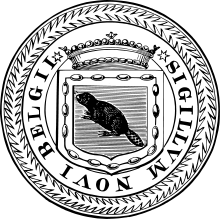Fort Ninigret
|
Fort Ninigret | |
 | |
|
Fort Ninigret in 2008 | |
 | |
| Location | Charlestown, Rhode Island |
|---|---|
| Coordinates | 41°22′52″N 71°38′54″W / 41.38111°N 71.64833°WCoordinates: 41°22′52″N 71°38′54″W / 41.38111°N 71.64833°W |
| Built | 1637 |
| Architect | Dutch West India Company |
| Architectural style | No Style Listed |
| NRHP Reference # | [1] |
| Added to NRHP | April 28, 1970 |
| New Netherland series |
|---|
| Exploration |
| Fortifications: |
| Settlements: |
| The Patroon System |
|
| People of New Netherland |
| Flushing Remonstrance |
 |
Fort Ninigret is an historic fort or trading post site at Fort Neck Road in Charlestown, Rhode Island, purportedly built and occupied by either Native Americans or early European settlers in the seventeenth century. At its 1883 Dedication, Commissioner George Carmichael, Jr. referred to it as "the oldest military post on the Atlantic coast."[2]
History
Archaeological excavations have shown that people lived on Fort Neck long before the Europeans arrived, although this was never a large village. But around 1620, many Niantic people (cousins and allies of the larger Narragansett tribe) settled at this place—growing corn, making wampum (shell beads used as money by the Europeans), and trading with the Dutch and the English for such things as beads, pipes, and copper kettles. By the 1630s, the Niantics had a young and powerful sachem—Ninigret, for whom the fort was later named.
Some historians have alleged that the fort was built by the Dutch West India Company or by Portuguese explorers prior to 1637 (in addition to the earlier trading post on nearby Dutch Island). One of the first printed references to Dutch forts in Rhode Island was Samuel Arnold's 1858 History of the State of Rhode Island. According to amateur historian Manuel da Silva:
"The fort is rectangular with the corners terminating in five-sided bastions, except for the one facing the water. It measures 152 feet long (from bastion to bastion) and 137 feet wide. The angles of the bastions are approximately 130 degrees. No one doubts that the style in which the fort is built clearly shows the influence of European civilization."[3]
In 1921−22 a European sword and cannon were found, along with many other grave goods, at an Indian cemetery near the site, which some people believe adds credence to the theory that this was a European fort. The artifacts are now in the possession of the Rhode Island Historical Society.
King Philip's War (1675–76) cemented English rule over most of the Indian lands of Rhode Island, but a reservation encompassing much of today's Charlestown was set aside for the tribe. Many Narragansetts had joined Ninigret's people for safety, and soon the name "Niantic" fell out of use. At Fort Ninigret, tribal members lived in wigwams into the 18th century. Nearby stood the European-style house of the sachems, who sold off tribal property to Englishmen to pay their debts. By the 19th century Fort Neck was the last piece of land held in common by the Narragansett Tribe that had access to salt water.
In 1883 the state abolished relations with the tribe, conferring the rights and duties of US citizenship upon its members. As part of this detribalization, the state transformed the remains of Fort Ninigret into a monument to the past 250 years of positive Narragansett-European relations. The state, under the direction of the Commissioners of the Narragansett Tribe of Indians, planted evergreens, reshaped the earthen banks of the fort, and erected an iron fence along the outlines of the old fort. A boulder was moved from the nearby hills and inscribed with these words:
Fort Ninigret
Memorial of the Narragansett and Niantic Indians
Unwavering Friends and Allies of Our Fathers
Erected by the State of Rhode Island
Dwight R. Adams, William P. Sheffield, Jr., George Carmichael, Jr.: Comrs
1883 [1]
Two members of the Indian Council spoke at the monument’s dedication: Gideon L. Ammons and Joshua H. Noka.[2]
In 1983 the federal government acknowledged that the Narragansetts were still alive and well in Rhode Island, and they were once again recognized as a tribe. Today Fort Ninigret is maintained by the Rhode Island Department of Environmental Management and the Charlestown Historical Society.
Fort Ninigret was added to the National Register of Historic Places in 1970. During the 1970s, archaeological excavations were conducted at Fort Ninigret by the Rhode Island Historical Preservation Commission and by archaeologists from New York University.
Images
-

Fort Ninigret in 2008
-

Fort Ninigret in 2008
-

Fort Ninigret in 2008
-

Fort Ninigret in 2008
-

Fort Ninigret in 2008
See also
References
- ↑ Staff (2007-01-23). "National Register Information System". National Register of Historic Places. National Park Service.
- 1 2
- ↑ American Edition of Portuguese Pilgrims and Dighton Rock, Manuel Luciano da Silva. Published in 1971
External links
| ||||||||||||||||||||||||||
| ||||||||||
| ||||||||||||||||||||||||||||||||||||||||||||||||||||||||||||||||||||||||||||||||||||||||||||||||||||||||||||||||||||||